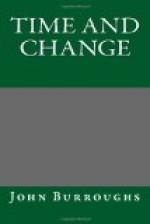The image of a tree is misleading from the fact that all the different branches of the animal kingdom, from the protozoa up to man, have come along with what we call the higher branches, the mammals; the suckers have kept pace with the main stalk, so that we have the image of a sheaf of branches starting from a common origin and all of equal length. Man has brought on his relations along with him.
There is no glamour of romance over that past. It was all hard, prosy, terrible fact. The earth’s crust was less stable than now, the upheavals and subsidences and earthquakes more frequent, the warring of the elements more fierce and incessant, deluge and inundation in more rapid succession, and the riot and excesses of animal life far beyond anything we know of. And our line of descent was taking its chances amid it all. The widespread blotting out of life at the end of Palaeozoic time, and again at the end of Mesozoic times, when myriads of forms were cut off, probably from some convulsion of nature or some cosmic catastrophe; and again during the ice age, when the camel, the llama, the horse, the tapir, the mastodon, the elephant, the giant sloth, became extinct in North America—how fared it with our ancestor during these terrible ages? There is no sure trace of him till late Tertiary times, and it is probably not more than two hundred thousand years ago that he assumed the upright attitude and began to use tools. Probably in Europe fifty thousand years ago he was living in caves, clothed in skins, contending with the cave bear and cave lion, using rude stone implements, and hunting the hairy mastodon, etc. In Asia the probabilities are that he was farther on the road toward the dawn of history.
We may think of our descent in the historic period under the image of the stream, though of a stream many times delayed and diverted, even many times diminished by wars and plagues and famine, but a stream with some sort of unity and continuity, since man became man. The stream of life is like any other stream in this respect. Divert or use up part of the water of a stream, yet what is left flows on and keeps up the continuity and identity of the stream; dip your cup into it here, and you will not get precisely the same water you would have got had none of it been diverted or used far back in its course—you get the water that was allowed to flow by.
Had there been no loss of life by war and pestilence and accidents of various kinds, the different countries would have been occupied by quite other men and women than those that fill them to-day. The course of life in every neighborhood is changed by what seem like accidental causes, as when a family is practically wiped out by some accident or dread disease. This brings new people on the scene. The farm or the business falls into other hands, and new social relations spring up, new men and women are brought together or the old ones driven apart, marriage is




